Subfamily Bombyliidae (True Bee Flies)
Bee Flies in the subfamily Bombyliinae usually have the stout and hairy body. They are from medium to large in size. They have long and thin proboscis. The wing vein M1 meets R5 before the wing margin. The head joint closely to thorax, i.e., no neck can be seen. The abdomen is board and oval. Flies in this subfamily is called True Bee Flies because their hairy body and flight habits resembles bees.
Wing with R4+5 branched; vein MA present; palpi present, usually large; abdominal spiracles in pleural membrane; mostly over 5 mm.
Antenna often thickened, scape usually shorter than flagellum; pronotum not distinct; body usually broad and usually densely hairy; wings normally broad and usually with well developed alula and squama; female with a well developed sand-chamber guarded by dense long hairs (except Beckerellus, but other characters do not differ), spermatheca with a distinct terminal bulb .
Annotated keys to the genera of African Bombylioidea (Diptera: Bombyliidae; Mythicomyiidae) by D. J. Greathead and N. L. Evenhuis
Africa Wild Insect Book Flies (Diptera)
Moderator: Klipspringer
Africa Wild Insect Book Flies Photos & Descriptions
Bombyliid Bee Fly Bombylella cf. delicata
Family: Bombyliidae. Subfamily: Bombyliinae. Tribe: Bombyliini
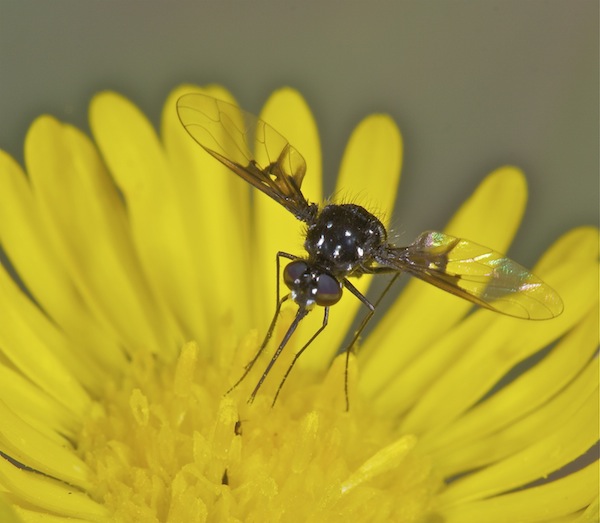
This species looks like the Bombylella delicata, figure , page 1020, Manual of Afrotropical Diptera, Volume 2: Nematocerous Diptera and Lower Brachycera Ashley H. Kirk-Spriggs and Bradley J. Sinclair (eds.) 2017
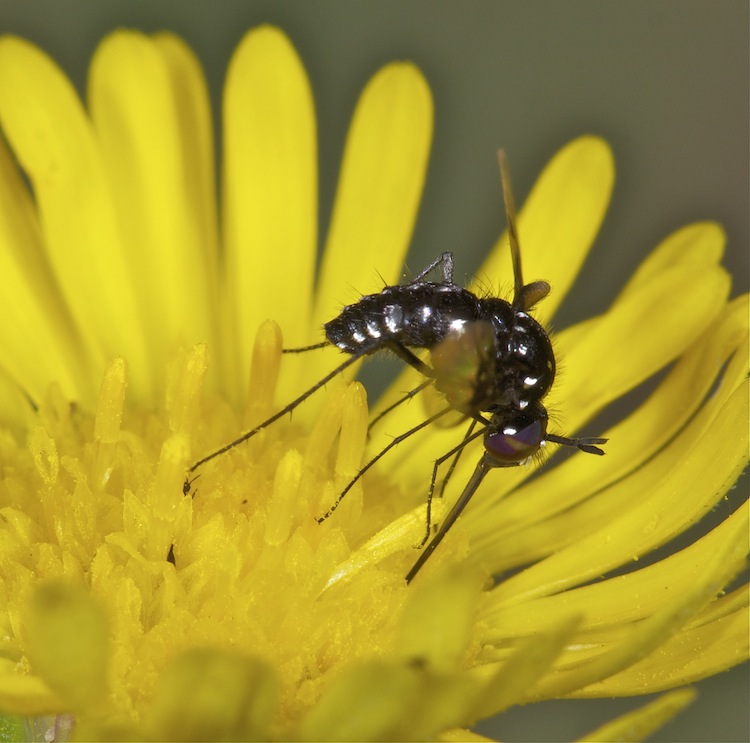
Imfolozi
Description
Bombylella sp. are a small, less than 10 mm, delicate slender species with long slender legs, alula long and narrow, and squama reduced. Those from Africa are with mainly black vestiture ornamented with tufts of bright colored hair or opalescent or metallic colored scales in spots on frons and often on thorax and abdomen. The ornamentation is probably for species recognition in dense vegetation (open forest, woodland).
Many Bombylella sp. are similar in appearance, although B. delicata is the most commonly encountered and a fairly widespread species.
Widespread species of Bombylella are B. elegans (Wiedemann), B. kilimandjarica (Speiser) and B. rufiventris (Macquart).
Distribution
Bombylella sp. are mainly Afrotropical, also southern Palaearctic and Oriental.
Biology
B. ornata and Bombylella sp. have been reared once each from dung balls of Scarabaeidae.
Both sexes feed on nectar but females also feed on pollen and many have specialised hairs on the fore tarsi for gathering pollen.
Links:
https://journals.co.za/docserver/fullte ... 120AB04AC7
Family: Bombyliidae. Subfamily: Bombyliinae. Tribe: Bombyliini

This species looks like the Bombylella delicata, figure , page 1020, Manual of Afrotropical Diptera, Volume 2: Nematocerous Diptera and Lower Brachycera Ashley H. Kirk-Spriggs and Bradley J. Sinclair (eds.) 2017

Imfolozi
Description
Bombylella sp. are a small, less than 10 mm, delicate slender species with long slender legs, alula long and narrow, and squama reduced. Those from Africa are with mainly black vestiture ornamented with tufts of bright colored hair or opalescent or metallic colored scales in spots on frons and often on thorax and abdomen. The ornamentation is probably for species recognition in dense vegetation (open forest, woodland).
Many Bombylella sp. are similar in appearance, although B. delicata is the most commonly encountered and a fairly widespread species.
Widespread species of Bombylella are B. elegans (Wiedemann), B. kilimandjarica (Speiser) and B. rufiventris (Macquart).
Distribution
Bombylella sp. are mainly Afrotropical, also southern Palaearctic and Oriental.
Biology
B. ornata and Bombylella sp. have been reared once each from dung balls of Scarabaeidae.
Both sexes feed on nectar but females also feed on pollen and many have specialised hairs on the fore tarsi for gathering pollen.
Links:
https://journals.co.za/docserver/fullte ... 120AB04AC7
Re: Africa Wild Insect Book Flies Photos & Descriptions
Bombyliid Bee Fly Bombylella sp.
Family: Bombyliidae. Subfamily: Bombyliinae. Tribe: Bombyliini
 © BluTuna
© BluTuna
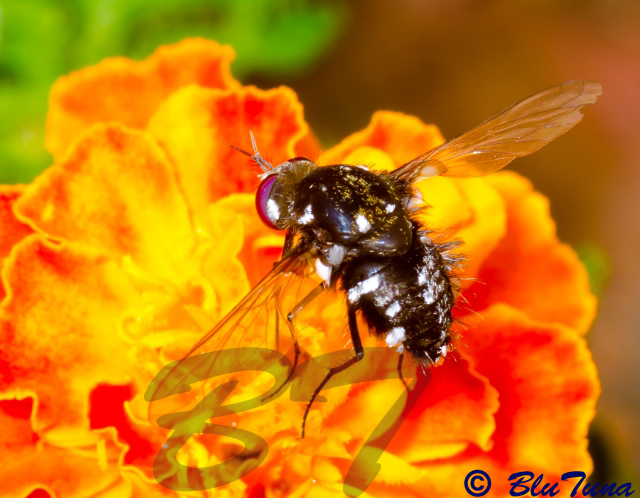 © BluTuna
© BluTuna
Hartebeespoort Dam area, North West Province
Family: Bombyliidae. Subfamily: Bombyliinae. Tribe: Bombyliini
 © BluTuna
© BluTuna © BluTuna
© BluTunaHartebeespoort Dam area, North West Province
Africa Wild Insect Book Flies Photos & Descriptions
Woolly Bee Fly Systoechus sp.
Family: Bombyliidae Subfamily: Bombyliinae. Tribe: Bombyliini
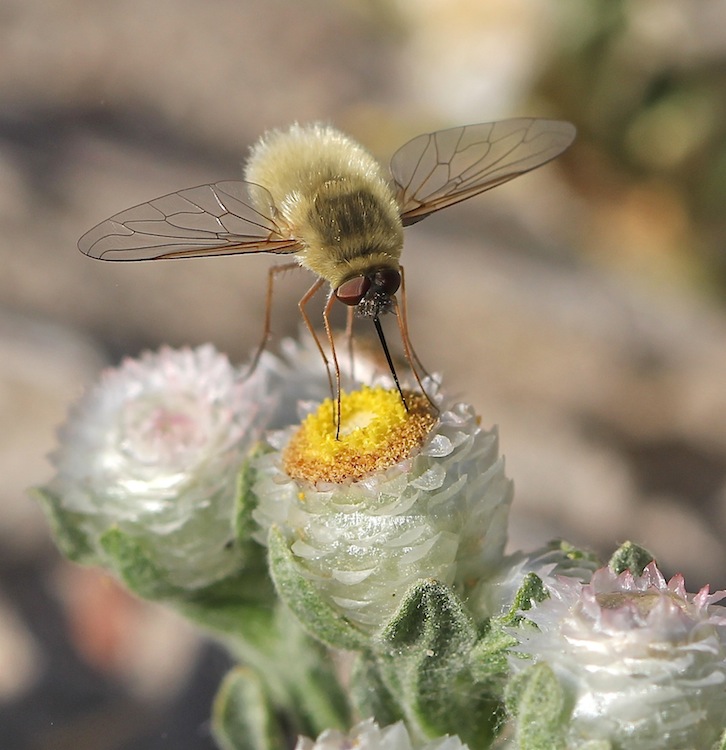
Kgalagadi Transfrontier Park (October)
Description
Stout and furry fly. Legs slender, long proboscis. Small (wingspan 14 mm), with broad head and body covered in plush frosty or chalky white hairs. Many species are known from the region.
Head usually narrower than thorax; hind margin of eye not indented. Cell br equal in length to bm; r-m usually much shorter than m-m, occasionally almost as long; cell r5 closed and stalked; vestiture fine and silky with a clipped appearance at least on occiput and thorax, hair long and dense, white to straw-yellow or brown shading to paler on underside; wing infuscation, if present, diffuse and darker along fore border; gonocoxae without a crest of strong spines or a tuft of long hairs on the dorsal surface, male with phallosome compact often with clasper-like outgrowths.
Habitat
Most common in arid sparsely vegetated areas. Karoo and bushveld.
Biology
Some species of economic importance as the larvae feed on eggs of Brown Locust Locustana pardalina.
Family: Bombyliidae Subfamily: Bombyliinae. Tribe: Bombyliini

Kgalagadi Transfrontier Park (October)
Description
Stout and furry fly. Legs slender, long proboscis. Small (wingspan 14 mm), with broad head and body covered in plush frosty or chalky white hairs. Many species are known from the region.
Head usually narrower than thorax; hind margin of eye not indented. Cell br equal in length to bm; r-m usually much shorter than m-m, occasionally almost as long; cell r5 closed and stalked; vestiture fine and silky with a clipped appearance at least on occiput and thorax, hair long and dense, white to straw-yellow or brown shading to paler on underside; wing infuscation, if present, diffuse and darker along fore border; gonocoxae without a crest of strong spines or a tuft of long hairs on the dorsal surface, male with phallosome compact often with clasper-like outgrowths.
Habitat
Most common in arid sparsely vegetated areas. Karoo and bushveld.
Biology
Some species of economic importance as the larvae feed on eggs of Brown Locust Locustana pardalina.
Diptera, Brachycera, Asiloidea, Bombyliidae, Lomatiinae
Subfamily Lomatiinae (Brown Bee Flies)
In this subfamily Lomatiinae, the Bee flies have long wings and narrow body. On each side the posterior surface of head is distinctly concave. They are usually brown to dark brown in colours. Their wing vein Rs forks well before r-m, with R4 and R5 strongly looped. The wings are usually in dark colour and some are patterned. They usually have the narrow and flattened abdomen.
Postcranium with a deep or shallow concavity surrounding occipital foramen. Clypeus reaching antennal sockets. Eyes with an indentation on the posterior margin; scape cylindrical or conical, without a ventral apical bulge; wings elongate, usually longer than body.
Annotated keys to the genera of African Bombylioidea (Diptera: Bombyliidae; Mythicomyiidae) by D. J. Greathead and N. L. Evenhuis
https://journals.co.za/content/nmsa_ai/42/1/EJC84477
In this subfamily Lomatiinae, the Bee flies have long wings and narrow body. On each side the posterior surface of head is distinctly concave. They are usually brown to dark brown in colours. Their wing vein Rs forks well before r-m, with R4 and R5 strongly looped. The wings are usually in dark colour and some are patterned. They usually have the narrow and flattened abdomen.
Postcranium with a deep or shallow concavity surrounding occipital foramen. Clypeus reaching antennal sockets. Eyes with an indentation on the posterior margin; scape cylindrical or conical, without a ventral apical bulge; wings elongate, usually longer than body.
Annotated keys to the genera of African Bombylioidea (Diptera: Bombyliidae; Mythicomyiidae) by D. J. Greathead and N. L. Evenhuis
https://journals.co.za/content/nmsa_ai/42/1/EJC84477
Re: Diptera, Bombyliidae
Bee Fly Notolomatia pictipennis
Family Bombyliidae. Subfamily Lomatiinae. Tribe Lomatiini
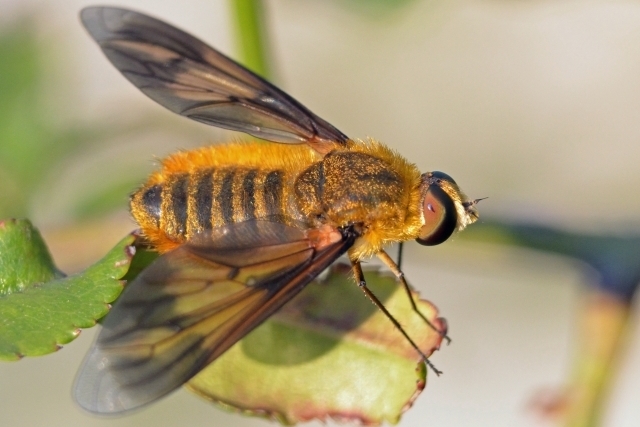 © BluTuna
© BluTuna
Garden in Johannesburg
Description
A medium-sized fly with a wingsan of 20 mm. Body black with dense tufts of black, white and yellow hairs on the sides of the broad flattened abdomen. Wings long and black with central dull orange patch. Short fleshy mouthparts.
Hind margin of eye indented; mesonotum with few bristles at sides, inconspicuous in front of wing; aedeagus pointed; spermathecal bulb short. Abdominal terga entirely black; adpressed scale-like hairs present on abdomen; abdominal cuticle dull, tomentose; spermathecal bulb pear-shaped. Wing only a little longer than body, not entirely infuscated, and with at least the apex hyaline; vein R4 without an appendix and with a rounded bend, vein m-m almost parallel to wing margin so that discal cell appears pointed.
It flies near the ground.
Taxonomic Note
Notolomatia was proposed for afrotropical species formerly included in Lomatia.
Distribution
Afrotropical.
Habitat
Open grassland and woodland.
Family Bombyliidae. Subfamily Lomatiinae. Tribe Lomatiini
 © BluTuna
© BluTunaGarden in Johannesburg
Description
A medium-sized fly with a wingsan of 20 mm. Body black with dense tufts of black, white and yellow hairs on the sides of the broad flattened abdomen. Wings long and black with central dull orange patch. Short fleshy mouthparts.
Hind margin of eye indented; mesonotum with few bristles at sides, inconspicuous in front of wing; aedeagus pointed; spermathecal bulb short. Abdominal terga entirely black; adpressed scale-like hairs present on abdomen; abdominal cuticle dull, tomentose; spermathecal bulb pear-shaped. Wing only a little longer than body, not entirely infuscated, and with at least the apex hyaline; vein R4 without an appendix and with a rounded bend, vein m-m almost parallel to wing margin so that discal cell appears pointed.
It flies near the ground.
Taxonomic Note
Notolomatia was proposed for afrotropical species formerly included in Lomatia.
Distribution
Afrotropical.
Habitat
Open grassland and woodland.
Diptera, Brachycera, Asiloidea, Bombyliidae, Anthraciinae
Subfamily Anthraciinae (Black Bee Flies and Stout Bee Flies)
The Anthracinae are the largest subfamily of the Bombyliidae in terms of numbers of species (~2,100 spp. in 170 genera of 6 tribes worldwide).
The tribes Anthracini, Exoprosopini and Villini are, for the most part, easily differentiated and allocated to the correct tribe, but the limits of the Aphoebantini, Prorostomatini and Xeramoebini in particular are not well defined.
Bee Flies in this subfamily usually large and stout. There are usually patterns on clear wings with patterns on the costal margin area. Clypeus not reaching antennal sockets. Eyes with an indentation on the posterior margin and at least an indication of a bisecting line; if exceptionally (some Prorostomatini) both characters are lacking, then R2+3 arises at right angles at a distance from origin of Rs. Frons at most only slightly tumid, face protruding or not; body slender or broad; usually densely covered with hair and/or scales and with well developed bristles; female with sand-chamber well differentiated and three spermathecae.
Annotated keys to the genera of African Bombylioidea (Diptera: Bombyliidae; Mythicomyiidae) by D. J. Greathead and N. L. Evenhuis
The Anthracinae are the largest subfamily of the Bombyliidae in terms of numbers of species (~2,100 spp. in 170 genera of 6 tribes worldwide).
The tribes Anthracini, Exoprosopini and Villini are, for the most part, easily differentiated and allocated to the correct tribe, but the limits of the Aphoebantini, Prorostomatini and Xeramoebini in particular are not well defined.
Bee Flies in this subfamily usually large and stout. There are usually patterns on clear wings with patterns on the costal margin area. Clypeus not reaching antennal sockets. Eyes with an indentation on the posterior margin and at least an indication of a bisecting line; if exceptionally (some Prorostomatini) both characters are lacking, then R2+3 arises at right angles at a distance from origin of Rs. Frons at most only slightly tumid, face protruding or not; body slender or broad; usually densely covered with hair and/or scales and with well developed bristles; female with sand-chamber well differentiated and three spermathecae.
Annotated keys to the genera of African Bombylioidea (Diptera: Bombyliidae; Mythicomyiidae) by D. J. Greathead and N. L. Evenhuis
Diptera, Brachycera, Asiloidea, Bombyliidae, Anthraciinae
Subfamily Anthraciinae, tribe Exoprosopini
The tribe Exoprosopini is characterised by having claws with a tooth (= conical spine-like pulvilli) at base, which separates it from the otherwise similar Villini. The Exoprosopini also invariably have an interradial crossvein between R2+3 and R4 (at least three submarginal cells), sometimes also cell r4 divided into two by a crossvein (4 submarginal cells); they usually have two flagellomeres, and are, mostly, larger than Villini.
Annotated keys to the genera of African Bombylioidea (Diptera: Bombyliidae; Mythicomyiidae) by D. J. Greathead and N. L. Evenhuis
The tribe Exoprosopini is characterised by having claws with a tooth (= conical spine-like pulvilli) at base, which separates it from the otherwise similar Villini. The Exoprosopini also invariably have an interradial crossvein between R2+3 and R4 (at least three submarginal cells), sometimes also cell r4 divided into two by a crossvein (4 submarginal cells); they usually have two flagellomeres, and are, mostly, larger than Villini.
Annotated keys to the genera of African Bombylioidea (Diptera: Bombyliidae; Mythicomyiidae) by D. J. Greathead and N. L. Evenhuis
Africa Wild Insect Book Flies Photos & Descriptions
Bee Fly Exoprosopa sp.
Family Bombyliidae. Subfamily: Anthracinae. Tribe: Exoprosopini


Nossob Camp, Kgalagadi Transfrontier Park (November)
Exoprosopa is a worldwide genus of flies belonging to the family Bombyliidae (bee-flies). Species are found worldwide, however Southern Africa is especially species rich with over 135 species. In South Africa most species occur in the wooded, summer-rainfall, northern parts of the region.
Family Bombyliidae. Subfamily: Anthracinae. Tribe: Exoprosopini


Nossob Camp, Kgalagadi Transfrontier Park (November)
Exoprosopa is a worldwide genus of flies belonging to the family Bombyliidae (bee-flies). Species are found worldwide, however Southern Africa is especially species rich with over 135 species. In South Africa most species occur in the wooded, summer-rainfall, northern parts of the region.
Diptera, Asiloidea, Bombyliidae, Anthraciinae, Xeramoebini
Subfamily Anthraciinae, tribe Xeramoebini
The tribe Xeramoebini was proposed by Hull (1973) for genera with the face not produced, vein R2+3 arising at a right-angle before or opposite crossvein r-m, and also metepisternum and mediotergite bare. Face rounded, not produced; femora without strong bristles below; body narrow, elongate to moderately broad.
Annotated keys to the genera of African Bombylioidea (Diptera: Bombyliidae; Mythicomyiidae) by D. J. Greathead and N. L. Evenhuis
The tribe Xeramoebini was proposed by Hull (1973) for genera with the face not produced, vein R2+3 arising at a right-angle before or opposite crossvein r-m, and also metepisternum and mediotergite bare. Face rounded, not produced; femora without strong bristles below; body narrow, elongate to moderately broad.
Annotated keys to the genera of African Bombylioidea (Diptera: Bombyliidae; Mythicomyiidae) by D. J. Greathead and N. L. Evenhuis


